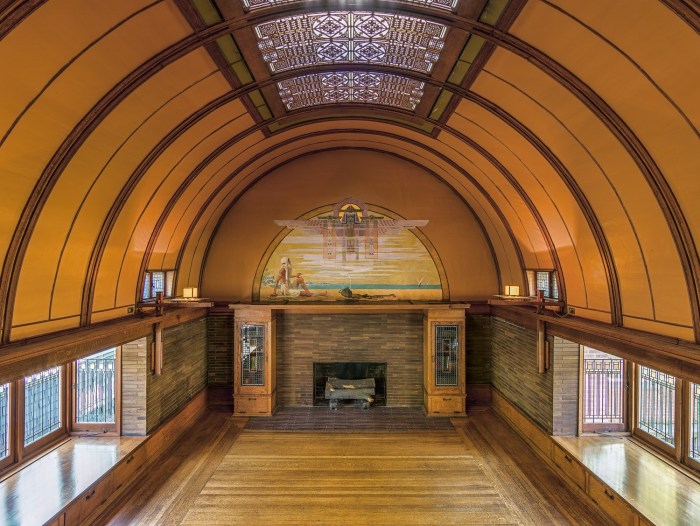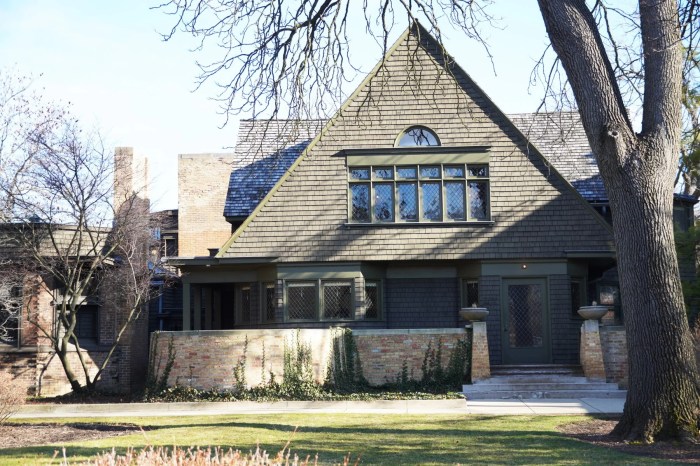Exploring the Timeless Charm of Frank Lloyd Wright Home and Studio
Embark on a journey through the iconic Frank Lloyd Wright Home and Studio, where architectural brilliance meets historical significance. Discover the unique design elements and captivating story behind this renowned masterpiece.
Overview of Frank Lloyd Wright Home and Studio

The Frank Lloyd Wright Home and Studio showcases the iconic architectural style of the renowned architect himself. Designed in the Prairie School style, this structure represents Wright's innovative approach to blending nature with modern design elements.
Architectural Style
The home and studio feature long horizontal lines, overhanging eaves, and a focus on natural materials such as wood and stone. Wright's use of open floor plans and integration of the surrounding landscape into the design sets it apart from traditional architectural styles of the time.
Historical Significance
Frank Lloyd Wright's Home and Studio holds immense historical significance as it served as his personal residence and workplace for many years. It became a laboratory where he experimented with new ideas and concepts that would later revolutionize modern architecture.
Layout and Design Elements
The unique layout of the home and studio reflects Wright's belief in organic architecture, where the structure should harmonize with its environment. From the use of geometric shapes to the emphasis on natural light, every design element in this space was carefully considered to create a cohesive and innovative living and working environment.
History of the Frank Lloyd Wright Home and Studio
The Frank Lloyd Wright Home and Studio, located in Oak Park, Illinois, holds significant historical value in the realm of architecture. Let's delve into the timeline of its construction, renovations, and notable events.
Construction Timeline
- The Home and Studio were built in 1889 when Frank Lloyd Wright was just 22 years old.
- Wright made several alterations and additions to the property between 1898 and 1909, reflecting his evolving architectural style.
Renovations and Additions
- In 1895, Wright added a studio to the property to accommodate his growing architectural practice.
- Between 1898 and 1909, he redesigned the interior and exterior of the home, incorporating elements of his famous Prairie School style.
Famous Guests and Events
- Over the years, the Frank Lloyd Wright Home and Studio has welcomed prominent figures such as Louis Sullivan, a renowned architect and mentor to Wright.
- In 1909, Wright hosted a gathering at the home with leading architects and artists, solidifying his reputation in the architectural community.
Architecture and Design Features

The architecture and design of the Frank Lloyd Wright Home and Studio showcase several distinctive features that characterize Wright's style, highlighting his innovative approach to creating spaces that blend seamlessly with nature.
Architectural Features
- Horizontal lines: Wright's signature use of horizontal lines helps to integrate the buildings with the surrounding landscape, creating a sense of harmony and flow.
- Cantilevered overhangs: The home and studio feature cantilevered overhangs that extend beyond the walls, adding a sense of weightlessness and modernity to the design.
- Open floor plan: Wright's open floor plan concept allows for flexible living spaces and a connection between interior and exterior areas.
- Use of natural light: Large windows and skylights are strategically placed throughout the buildings to bring in natural light, enhancing the overall ambiance.
Materials Used
The construction of the Frank Lloyd Wright Home and Studio showcases the use of materials such as limestone, brick, and wood. These materials not only blend harmoniously with the natural surroundings but also reflect Wright's commitment to using organic materials that age gracefully over time.
Influence of Nature
Wright was deeply inspired by nature, and this is evident in the design of the home and studio. The buildings are surrounded by lush greenery, and large windows frame views of the landscape, blurring the boundaries between indoor and outdoor spaces.
The use of natural materials and the incorporation of nature-inspired elements throughout the design pay homage to the beauty of the surrounding environment.
Interior Spaces and Furnishings
The interior of the Frank Lloyd Wright Home and Studio is a testament to his innovative design principles and attention to detail. The space is meticulously planned to create a harmonious flow between rooms while maximizing natural light and ventilation.
Layout of the Home and Studio
The home and studio are seamlessly integrated, with the living quarters connected to the workspace. The open floor plan allows for flexibility and fluidity between different areas, blurring the lines between work and leisure.
Iconic Furniture Pieces and Design Elements
One of the most iconic furniture pieces in the home is the dining table and chairs designed by Frank Lloyd Wright himself. The furniture features clean lines, geometric shapes, and natural materials, showcasing his commitment to organic architecture.
Reflection of Wright’s Design Principles
The interior spaces of the home and studio reflect Wright's design principles of unity, harmony, and simplicity. Every detail, from the furniture to the lighting fixtures, is carefully considered to create a cohesive and visually appealing environment. The use of natural materials and earth tones further emphasizes Wright's connection to nature and his belief in creating architecture that is in harmony with its surroundings.
Influence and Legacy
The Frank Lloyd Wright Home and Studio has had a profound impact on modern architecture, shaping the way architects approach design and construction. Wright's innovative ideas and unique style continue to influence architectural trends to this day.
Impact on Modern Architecture
The Frank Lloyd Wright Home and Studio served as a laboratory for Wright's experimentation with organic architecture, where buildings are integrated with their natural surroundings. This concept has been widely adopted by modern architects who seek to create sustainable and environmentally-friendly structures that harmonize with the environment.
- The open floor plan of the home, with its flowing spaces and abundant natural light, has inspired countless contemporary designs that prioritize connectivity and interaction within living spaces.
- Wright's use of innovative materials and techniques, such as cantilevered balconies and expansive windows, has influenced the development of modern building technologies and construction methods.
- The integration of the home's interior and exterior spaces, blurring the boundaries between nature and architecture, has become a hallmark of modern design that seeks to create a seamless transition between indoor and outdoor living.
Impact on Wright’s Career and Reputation
The success of the Frank Lloyd Wright Home and Studio not only solidified Wright's reputation as a visionary architect but also propelled his career to new heights. The recognition and acclaim garnered from this project opened doors for Wright to work on larger and more prestigious commissions, allowing him to further develop his signature style and design philosophy.
The Frank Lloyd Wright Home and Studio served as a testament to Wright's creative genius and innovative approach to architecture, establishing him as a leading figure in the field.
Architectural Movements and Styles Inspired
The Frank Lloyd Wright Home and Studio has influenced various architectural movements and styles, serving as a source of inspiration for designers across the globe.
- The Prairie School movement, which emphasized horizontal lines, open floor plans, and integration with nature, drew heavily from Wright's work at his home and studio.
- The Mid-Century Modern style, with its focus on simplicity, functionality, and connection to the outdoors, reflects Wright's principles of organic architecture and spatial harmony.
- Contemporary architects continue to look to the Frank Lloyd Wright Home and Studio for inspiration, incorporating elements of his design philosophy into their own projects to create spaces that resonate with modern sensibilities.
Outcome Summary
In conclusion, the Frank Lloyd Wright Home and Studio stands as a testament to innovation and creativity, leaving a lasting impact on modern architecture. Its influence continues to inspire generations, shaping the way we perceive design and space.
Essential Questionnaire
When was the Frank Lloyd Wright Home and Studio built?
The home and studio were built in 1889.
What materials were used in the construction?
Frank Lloyd Wright used materials like brick, wood, and glass in the construction.
How has the surrounding environment influenced the design?
The design of the home and studio integrates nature seamlessly, reflecting Wright's organic architecture principles.




